Vintage Detectives: Supernatural Sleuths, Sci-Fi Private Eye, and Isaac Asimov’s Detectives, edited by Gardner Dozois, Sheila Williams, Charles G. Waugh, and Martin H. Greenberg
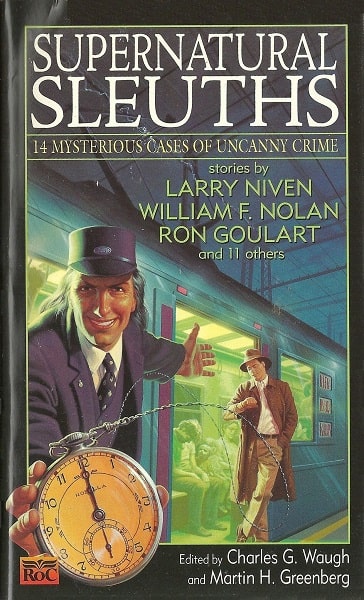 |
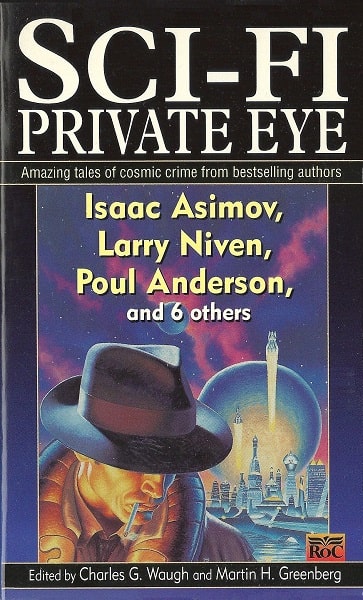 |
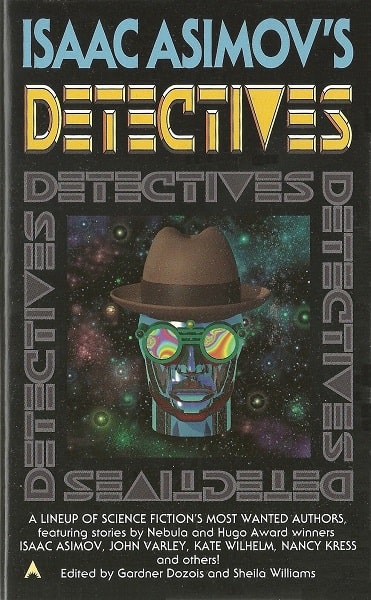 |
Supernatural Sleuths and Sci-Fi Private Eye (Roc, 1996 and 1997), and
Isaac Asimov’s Detectives (Ace, 1998). Covers by Romas Kukalis, uncredited, and Andy Lackow
Science fiction detectives have been a popular theme for anthologies for a couple of generations now. We’ve covered a few (including Tin Stars, edited by Isaac Asimov, Martin H. Greenberg, and Charles G. Waugh), but there’s lot more out there for the curious and the collector alike.
I’ve recently been dipping into some themed anthologies from the 80s and 90s, and three that have impressed me all have themes of detection: Supernatural Sleuths and Sci-Fi Private Eye (both published by Roc, in 1996 and 1997), and Isaac Asimov’s Detectives (Ace, 1998). They gather a fabulous cross section of 20th Century cross-genre fiction, including a John the Balladeer tale by Manly Wade Wellman, a Black Widowers story by Isaac Asimov, a Solar Pons mystery by August Derleth and Mack Reynolds, a Carnacki adventure by William Hope Hodgson, a Jules de Grandin novelette by Seabury Quinn, and a pair of Gil Hamilton novellas by Larry Niven, plus a rich range of major award-winning and nominated SF from Nancy Kress, Greg Egan, Kate Wilhelm, John Varley, and more.
[Click the images to solve the mystery of small print.]
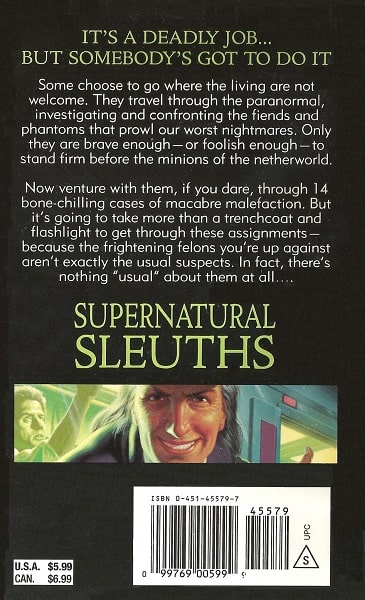 |
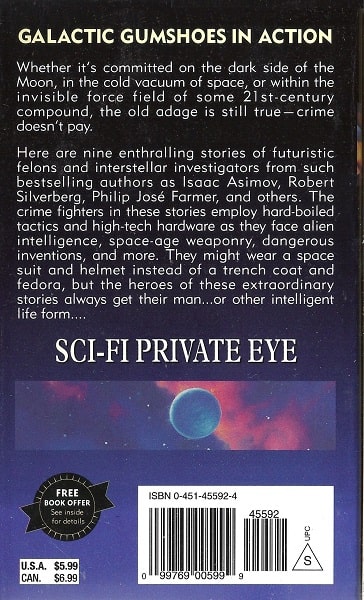 |
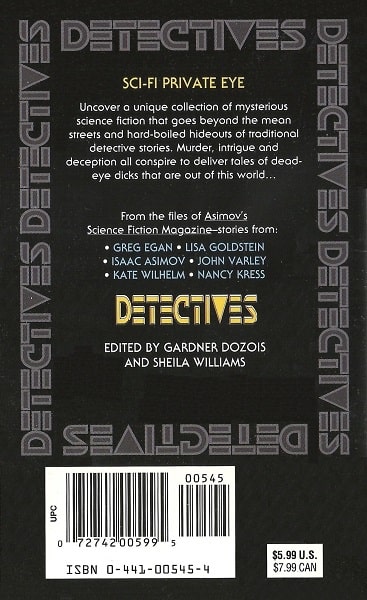 |
Back covers for Supernatural Sleuths, Sci-Fi Private Eye and Isaac Asimov’s Detectives
Martin H. Greenberg and Charles G. Waugh were the kings of the science fiction anthology. They produced nearly a hundred with Isaac Asimov before his death in 1992, and many more afterwards. All told the two published over 200 anthologies together between 1979 and Greenberg’s death in 2011. That’s an extraordinarily productive partnership — that’s more anthologies than I’ve read in the last fifty years.
The first SF/mystery from the three amigos of SF anthologies was The 13 Crimes of Science Fiction, published in 1979, a very fine volume with stories from Tom Reamy, Randall Garrett, Avram Davidson, Jack Vance, Philip K. Dick, Isaac Asimov, Larry Niven, Clifford D. Simak, and many others. Sadly it was never released in paperback, so I’m not sure I even have a copy (something I expect to rectify very shortly).
Supernatural Sleuths was edited by Waugh and Greenberg and published by Roc in 1996. Unlike the other two books we’re going to cover today, it has a strong fantasy focus, with a John the Balladeer tale by Manly Wade Wellman, a Solar Pons story by August Derleth and Mack Reynolds, a Carnacki adventure by William Hope Hodgson, a Jules de Grandin novelette by Seabury Quinn, and a Gil Hamilton novella by Larry Niven, plus stories by William F. Nolan, Ron Goulart, Lee Killough, Robert Weinberg, and Paul Levinson.
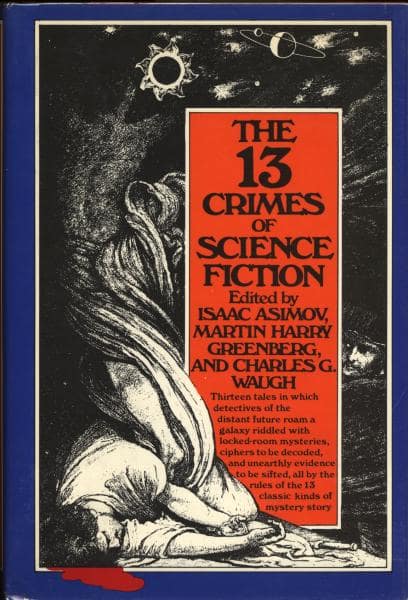 |
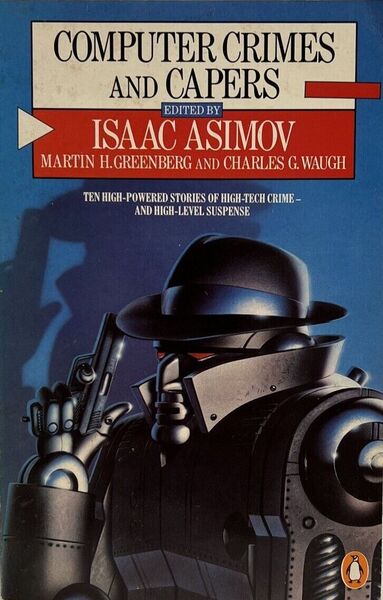 |
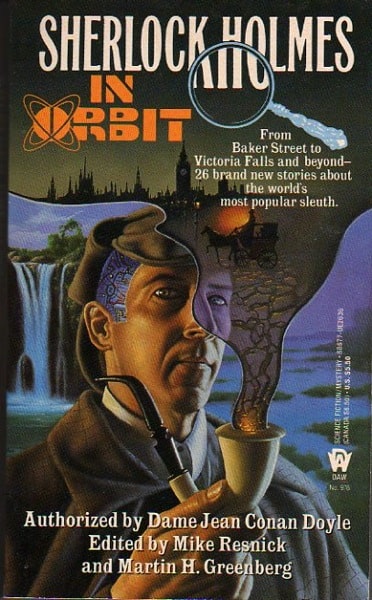 |
More sleuthing anthologies from the three amigos of SF anthologies: Asimov, Greenberg and Waugh.
The 13 Crimes of Science Fiction (Doubleday, 1979), Computer Crimes and Capers (Penguin Books, 1986), and
Sherlock Holmes in Orbit (DAW, 1995), with Mike Resnick. Covers by One Plus One Studio, uncredited, and Jim Warren
Believe it or not, I was sold on Supernatural Sleuths after reading a short Amazon review by a reader who goes by Ron, who said (in part):
I give the editors credit for including many different types of supernatural beings and phenomena it’s not all ghosts or vampires (just a few.)
“Lonely Train a’ Comin'” by William F. Nolan — a Montana rancher sets out to avenge the death of a loved one which he believes happened on a train that authorities claim can’t exist. ****
“Vandy, Vandy” by Manly Wade Wellman — a wanderer comes across a family in an isolated valley and helps them in their struggle against an unwanted suitor for their daughter. ***
“The Ghost Patrol” by Ron Goulart — a ghost hunter (and some ghosts) try to help a doctor being harassed by narrow-minded conservatives opposed to any government free-loading, including the clinic the doctor runs. **
“Gateway of the Monster” by William Hope Hodgson — Carnaki the Ghost Finder recounts a terrifying encounter in a haunted room in which at least three people have died under mysterious circumstances. *****
“The Angel of the Lord” by Melville Davisson Post — Uncle Abner confronts a neighbor intent on theft who seems to be taken over by a more powerful personality than his old self. ***
“The Existential Man” by Lee Killough — a police detective has strange feelings about a discovered corpse which has connections to a cold case he was involved in. ****
“The Midnight El” by Robert Weinberg — a private detective who can often see dead people looks for a client’s loved one on a train ferrying dead souls to the next plane. *****
Read the complete review here.
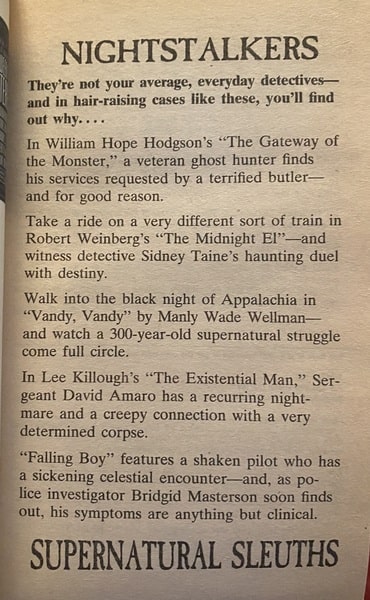 |
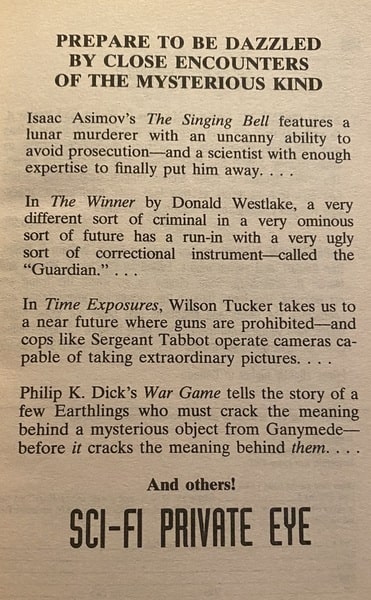 |
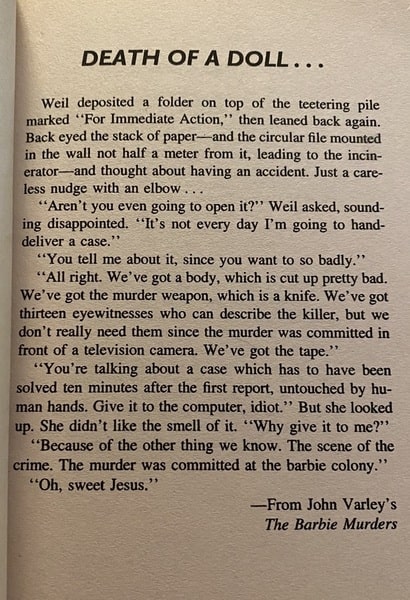 |
Inside cover pages for Supernatural Sleuths, Sci-Fi Private Eye and Isaac Asimov’s Detectives
Sci Fi Private Eye includes a Hugo-nominated Gil Hamilton novella by Larry Niven, plus stories by Isaac Asimov, Poul Anderson, Philip José Farmer, Donald E. Westlake, Tom Reamy, Wilson Tucker, Robert Silverberg, and Philip K. Dick.
Sbuchler has an entertaining breakdown of the contents at Goodreads.
The stories were much more readable then I expected… the stories played fair with the mysteries, the sci-fi elements, and did not use techno-babble to solve the crime. Each had an interesting take on the future and future technology. (For all the mentions of slide-rules and room-size computers were amusing, they do not actually distract from the stories).
Larry Niven’s “ARM” — This is the longest story in the book, and had the most interesting (albeit somewhat bleak) view of the future. The story follows the investigation of the murder of an Einstein-like (or more accurately a Thomas Edison-like) famous inventor, by a detective from the ARM branch of government, [whose] job is to police the population to make sure the reproductive laws are followed (which our hero hates doing), track down organ theft (since in this tech you can apparently easily transplant an arm, etc. from one person to another), and follow the advent/use of fancy new technological weapons — which is the classification that the murder of the inventor seems to fall into.
Isaac Asimov’s “The Singing Bell” — I think this was my favorite of the stories, very much a puzzle story without much action; but it was short, played fair and had an apropos resolution.
Wilson Tucker’s “Time Exposures” — A completely fair mystery that involves a time-lapse photographer. Except in this universe photography apparently can take pictures _backwards_ in time. Highly satisfying.
Poul Anderson’s “The Martian Crown Jewels” — almost feels like a Sam Spade pot-boiler crossed with Retief.
Robert Silverberg’s “Getting Across” — more an exploration of a future society then a mystery. Interesting in a vaguely post-apocalyptic “Mad Max and the Thunder dome” kind of way.
Philip Jose Farmer’s “A Scarletin Study” — think Sherlock Holmes, if Holmes were a genetically engineered intelligent dog.
Read the full review here.
Eleven of the 17 Isaac Asimov’s anthologies edited by Gardner Dozois and Sheila Williams,
published by Ace Books between 1991-2001. This set sold on eBay for $24 in January.
Isaac Asimov’s Detectives was the tenth volume in the popular Isaac Asimov’s anthologies series edited by Gardner Dozois and Sheila Williams and published by Ace Books between 1991-2001. They exclusively reprinted tales from Asimov’s Science Fiction magazine, and there were 17 in total:
Isaac Asimov’s Robots (1991)
Isaac Asimov’s Earth (1992)
Isaac Asimov’s Cyberdreams (1994)
Isaac Asimov’s Ghosts (1995)
Isaac Asimov’s Skin Deep (1995)
Isaac Asimov’s Vampires (1996)
Isaac Asimov’s Moons (1997)
Isaac Asimov’s Christmas (1997)
Isaac Asimov’s Camelot (1998)
Isaac Asimov’s Detectives (1998)
Isaac Asimov’s Solar System (1999)
Isaac Asimov’s Valentines (1999)
Isaac Asimov’s Werewolves (1999)
Isaac Asimov’s Mother’s Day (2000)
Isaac Asimov’s Utopias (2000)
Isaac Asimov’s Father’s Day (2001)
Isaac Asimov’s Halloween (2001)
Isaac Asimov’s Detectives contains only six stories, but they are all quite substantial, including a Black Widowers tale by Isaac Asimov, Hugo nominated short stories by John Varley and Greg Egan, plus Kate Wilhelm’s Nebula Award-nominated novella “The Gorgon Field” and Nancy Kress’s Hugo nominated novella “Fault Lines.”
Kim Fawcett reviewed the book at my old website SF Site in 1998. Here’s what she said, in part.
Six detective stories by six of the industry’s biggest names, carefully selected by two well-known editors — what could go wrong? Very little. In fact, this anthology’s biggest fault is that, at 243 pages, it’s far too short. However, editors Gardner Dozois and Sheila Williams chose their six stories well; originally published in Asimov’s Science Fiction magazine between 1978 and 1995, together they present a great cross-section of science fiction and fantasy.
The stories are all good, and two are positively exceptional. Greg Egan’s all-too-possible “Cocoon,” for instance, is a chilling study in human nature. Set not too far in the future, gays and lesbians have finally achieved such a level of acceptance in society that some, like detective James Glass, no longer feel that their sexuality matters any more than the colour of their eyes. But does it? When Glass starts investigating the destruction of a genetic engineering research centre, the answers he finds lead him to doubt the true hearts of everyone around him. It’s hard to make this story sound as enticing yet disturbing as it is without giving away the plot. I can tell you that it left me in denial, and as much as I’d love to believe that Egan’s insights into human behaviour are off the mark, a persistent set of goose bumps say otherwise.
And then there’s Nancy Kress’s, “Fault Lines” — more goose bumps… Retired cop Gene Shaunessy sleepwalks through day after day as a teacher. His wife lies comatose after a hit-and-run accident, and his visits to her have become little more than part of his routine. He is lonely, bitter, and withdrawn, and so when an old friend calls looking for help, Shaunessy tries to shrug him off. Elderly people are killing themselves in pairs, but they are all active, happy people in love with each other. So why the suicides? Shaunessy runs into obstacle after obstacle as he reluctantly searches for the true answer, while desperately trying to hold onto his comforting numbness. This story won’t leave you basking in afterglow, but it will make you value life, and love, more highly.
“The Barbie Murders” is another delightful story, this time from John Varley. The most SF of the lot, this story takes place on a lunar colony. Now, imagine this — you’re a cop who’s assigned a murder case. Easy job, open and shut. The entire murder is on video, with lots of witnesses, and you even have the murder weapon. Great, except that both victim and murderer belong to a cult that practices complete uniformity. Every member is completely identical. No fingerprints. No names. No possessions. No pasts. So how do you find one specific individual in a group where individuality is a crime? And what possible motive could a “barbie” have for murder? “The Barbie Murders” is an engaging projection of everyone’s desire to fit in. One word: cool…
Both Lisa Goldstein’s “Rites of Spring” and Kate Wilhem’s “The Gorgon Field” are well worth reading, and add a welcome fantasy element to the collection. The latter also adds some chills to leave you sleepless, if you make the mistake I made and try to read it at bedtime.
Read her full article here.
Here’s the Table of Contents for Supernatural Sleuths.
“Lonely Train A’Comin'” by William F. Nolan (Gallery, October 1981)
“Vandy, Vandy” by Manly Wade Wellman (The Magazine of Fantasy and Science Fiction, March 1953)
“The Ghost Patrol” by Ron Goulart (The Magazine of Fantasy and Science Fiction, October 1968)
“The Adventure of the Ball of Nostradamus” by August Derleth and Mack Reynolds (The Magazine of Fantasy and Science Fiction, June 1955)
“The Gateway of the Monster” by William Hope Hodgson (The Idler, January 1910)
“A Good Judge of Character” by Susan Dunlap (Deadly Allies, 1992)
“The Angel of the Lord” by Melville Davisson Post (The Saturday Evening Post, 1911)
“Falling Boy” by David Dean (Ellery Queen Mystery Magazine, April 1995)
“The Existential Man” by Lee Killough (The Magazine of Fantasy & Science Fiction, March 1982)
“The Midnight El” by Robert Weinberg (Return to the Twilight Zone, 1994)
“The Cardula Detective Agency” by Jack Ritchie (Alfred Hitchcock’s Mystery Magazine, March 1977)
“The Chronology Protection Case” by Paul Levinson (Analog Science Fiction and Fact, September 1995)
“Children of Ubasti” by Seabury Quinn (Weird Tales, December 1929)
“Death by Ecstasy” by Larry Niven (Galaxy Magazine, January 1969)
And here’s the TOC for Sci Fi Private Eye.
Introduction by Martin H. Greenberg and Charles G. Waugh
“The Singing Bell” by Isaac Asimov (The Magazine of Fantasy and Science Fiction, January 1955)
“The Martian Crown Jewels” by Poul Anderson (Ellery Queen’s Mystery Magazine, February 1958)
“A Scarletin Study” by Philip José Farmer (The Magazine of Fantasy and Science Fiction, March 1975)
“The Winner” by Donald E. Westlake (Nova 1, 1970)
“The Detweiler Boy” by Tom Reamy (The Magazine of Fantasy and Science Fiction, April 1977)
“Time Exposures” by Wilson Tucker (Universe 1, 1971)
“Getting Across” by Robert Silverberg (Future City, 1973)
“War Game” by Philip K. Dick (Galaxy Magazine, December 1959)
“ARM” by Larry Niven (Epoch, 1975) — Hugo Award Nominee, Locus Award nominee
And finally, the TOC for Isaac Asimov’s Detectives.
“The Barbie Murders” by John Varley (Isaac Asimov’s Science Fiction Magazine, January-February 1978) — Hugo nominee, Locus Award winner
“Cocoon” by Greg Egan (Asimov’s Science Fiction, May 1994) — Hugo nominee, SF Chronicle and Ditmar Award winner
“The Gorgon Field” by Kate Wilhelm (Isaac Asimov’s Science Fiction Magazine, August 1985) — Nebula nominee, World Fantasy Award nominee
“Rites of Spring” by Lisa Goldstein (Asimov’s Science Fiction, March 1994)
“The Backward Look” by Isaac Asimov (Isaac Asimov’s Science Fiction Magazine, September 1979)
“Fault Lines” by Nancy Kress (Asimov’s Science Fiction, August 1995) — Hugo nominee, Sturgeon Award nominee
Here’s the complete publishing details for all three:
Supernatural Sleuths (Roc, 348 pages, $5.99 in paperback, October 1, 1996) — cover by Romas Kukalis
Sci Fi Private Eye (Roc, 353 pages, $5.99 in paperback, March 1997) — cover uncredited
Isaac Asimov’s Detectives (Ace Books, 243 pages, $5.99 in paperback, July 1998) — cover by Andy Lackow
All three books were paperback originals. None have been reprinted, and there are no digital editions I’m aware of.
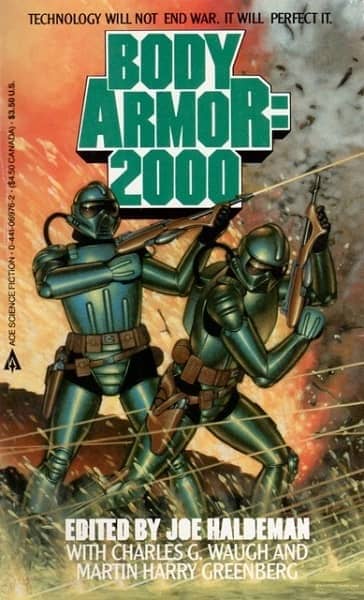 |
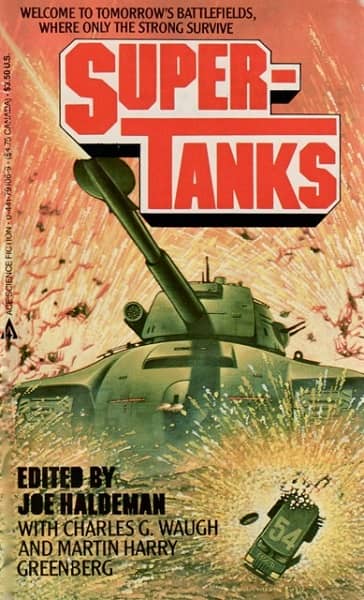 |
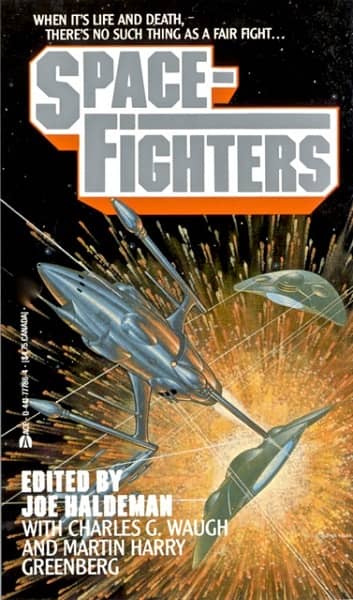 |
The Tomorrow’s Warfare Anthologies, edited by Joe Haldeman, Charles G. Waugh,
and Martin Harry Greenberg. Ace Books, 1989 and 1990. Covers by Walter Velez
Our previous coverage of anthologies by Martin H. Greenberg and Charles G. Waugh includes:
The Seven Deadly Sins of Science Fiction, edited by Isaac Asimov, Martin H. Greenberg, and Charles G. Waugh
Isaac Asimov’s Wonderful Worlds of Science Fiction 1: Intergalactic Empires, edited by Isaac Asimov, Martin H. Greenberg, and Charles G. Waugh
Isaac Asimov’s Wonderful Worlds of Science Fiction 5: Tin Stars, edited by Isaac Asimov, Martin H. Greenberg, and Charles G. Waugh
Isaac Asimov’s Wonderful Worlds of Science Fiction 10: Invasions, edited by Isaac Asimov, Martin H. Greenberg, and Charles G. Waugh
Isaac Asimov’s Magical Worlds of Fantasy 10: Ghosts, edited by Isaac Asimov, Martin H. Greenberg, and Charles G. Waugh
13 Short Fantasy Novels, 13 Short Science Fiction Novels, and 13 Short Horror Novels, edited by Isaac Asimov, Martin H. Greenberg, and Charles G. Waugh
The Space Anthologies, edited by David Drake with Charles G. Waugh and Martin Harry Greenberg
The Tomorrow’s Warfare Anthologies, edited by Joe Haldeman, Charles G. Waugh, and Martin Harry Greenberg
See all our recent Vintage Treasures articles here.
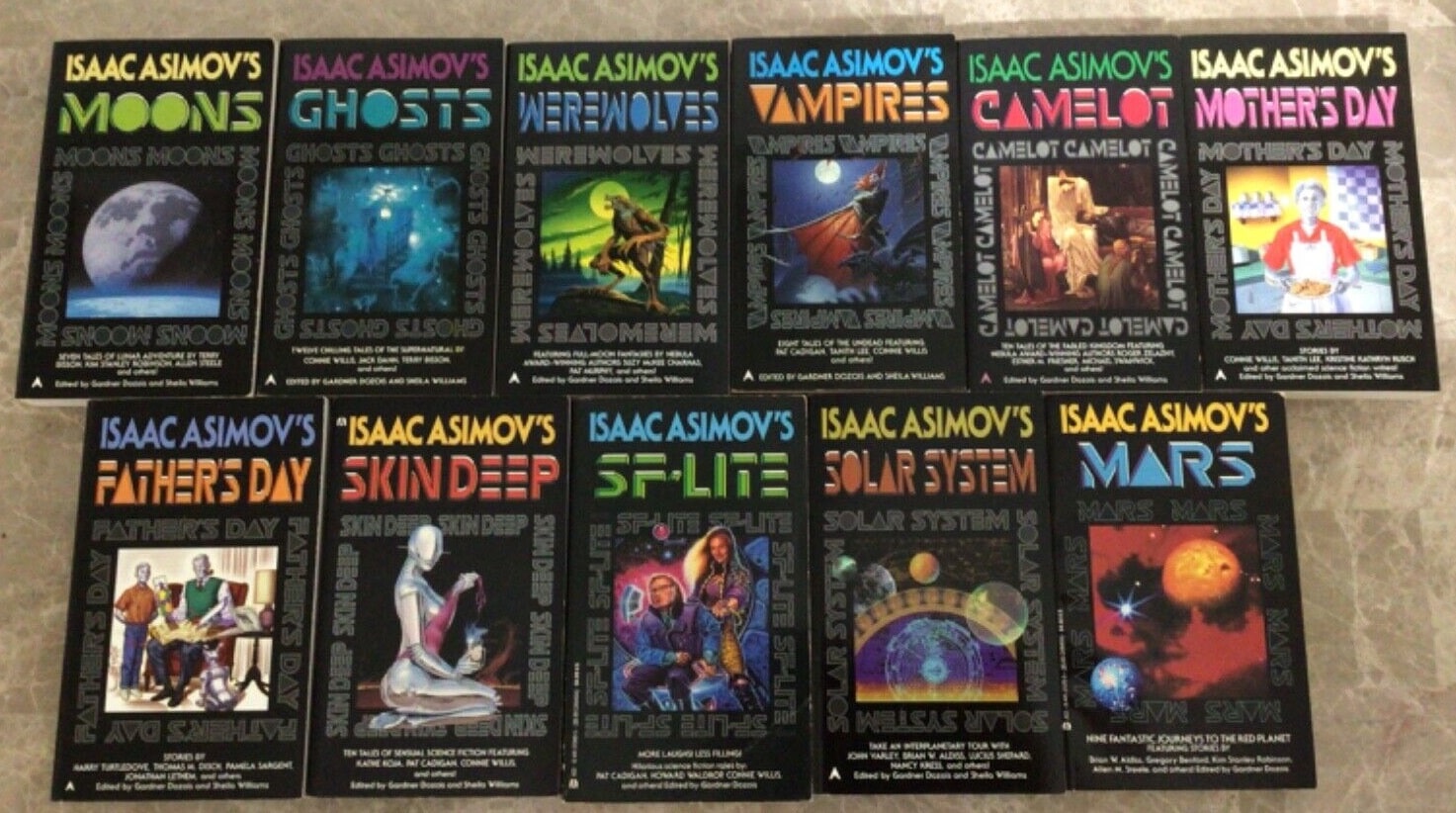
Just about everything you could want to know about the Mack Reynolds – August Derleth Solar Pons stories.
https://www.blackgate.com/2014/12/08/the-public-life-of-sherlock-holmes-the-science-fictional-solar-pons/
That’s a magnificent article, Bob. Thanks for the link!
So pleased to see this current appreciation of Supernatural Sleuths, which had the first of many reprints of my novelette, “The Chronology Protection Case”. That story was subsequently made into a Edgar-nominated radio play https://www.amazon.com/The-Chronology-Protection-Case-Dramatized/dp/B0007V43C8 and a low-budget movie https://www.amazon.com/Chronology-Protection-Case-Jay-Kensinger/dp/B00NEH25KY
Paul — you’re most welcome. I was astounded to see that “The Chronology Protection Case” has been reprinted over half a dozen times — that’s the definition of a modern classic.
What’s the best way to find more stories featuring the fascinating Dr. Phil D’Amato?
Thanks, John! Check out The Silk Code, and its two sequels https://www.amazon.com/dp/B0091W43JW
Thanks Paul — will do! I picked up the Tor paperback in 2000, but I hadn’t made the connection that it featured the same forensic detective. Most excellent!
i have detectives which i swear you talked about years ago, but now i need sci-fi private eye, and man what a name for an anthology! might have to pick up another hard copy of a book after all.
I don’t remember discussing Isaac Asimov’s Detectives before… but it certainly wouldn’t be the first time I’ve covered a book twice. 🙂 Maybe your memory is just better than mine.
Many thanks for this post! I’ve always loved genre crossovers and mixtures of science fiction, supernatural, detective stories, etc.
You’re very welcome. Carl. If you can think of any more, we’re wide open to recommendations!
I recently stumbled on another reprint anthology from the same era — Future Crimes, edited by Jack Dann and Gardner Dozois, containing tales by Algis Budrys, Kristine Kathryn Rusch, Harlan Ellison, C. M. Kornbluth, Kim Stanley Robinson, Brian Stableford, and Tony Daniel. Looks like an excellent line-up that would appeal to anyone interested in the books discussed above. It was published by Ace in 2003.
There was an original DAW anthology with the same title from Martin H. Greenberg and John Helfers in 1999, containing new stories by Alan Dean Foster, Craig Shaw Gardner, Will Murray, Alan Rodgers, Tom Piccirilli, Ron Goulart, Gary A. Braunbeck, Peter Crowther, and many others. Could be interesting.
Good takes on the anthologies, though in the headline you go Bah (or Baugh) at Waugh. I would probably at least give all three a look, even the one using “sigh-fie” for a rhyming title, which doesn’t endear me to the effort.
Todd,
Ack! You are absolutely correct, and I overlooked that egregious error for over a week. Thanks for pointing it out!
I have corrected it, and most humble apologies to professor Waugh.